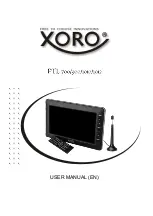
19
Check Water & Brine Solenoid Valve Integrity
One or both solenoids may eventually wear and allow a small discharge flow of water when normally closed.
One of the reasons the Hyprolyser
®
may alarm in “VOLTAGE HIGH” is due to the water solenoid valve inadvertently
passing water and producing a low salinity brine solution entering the electrolytic cell.
One of the reasons the Hyprolyser
®
may alarm in “VOLTAGE LOW” is due to the brine solenoid inadvertently
passing brine, allowing a high salinity brine solution to build up in the electrolytic cell.
Precondition for action:
Isolate the power supply to the HYPROLYSER
®
via the rotary isolator switch.
Perform the following working steps:
1.
Remove the HYPROLYSER
®
front outer red plastic protective mechanical cover by removing the two black protective nut
caps. Unscrew the two nuts and remove the red cover.
2.
Detach the flexible tubing from out of the top exit point of the relevant solenoid valve (or both solenoid valves during major
service). Remember to push the tube fitting collar down with finger and thumb to enable the release of the tubing.
3.
There should be no water passing/leaking through the solenoid valve. If there is any slight leakage then the solenoid should
be dismantled and cleaned or replaced.
4.
After checking/replacing the water solenoid valve, reinsert the tubing into the tube fitting. Ensure the tube fully engages into
the tube fitting to make a water tight seal.
5.
Start-up the system.
The solenoid valves have been successfully checked/replaced.
Hydrogen Gas Detector Inspection
The hydrogen gas (H
2
) detection system is very important to ensure a safe environment. The H
2
detector should be routinely
tested annually in order to verify a safe system of work. For reference, a hydrogen sensor reading of 100% is equivalent to less
than 25% of the Hydrogen LEL value. The H
2
level detected in the immediate atmosphere is displayed on the screen and should
normally be below 50%. This reading can be displayed by scrolling DOWN at the HYPROLYSER
®
panel to reveal Eng. Display
4:
Precondition for action:
HYPROLYSER
®
System in normal automatic operation.
Perform the following working steps:
1.
Prepare the HYPROLYSER
®
H
2
test device (available separately) as per device instructions.
2.
Position the tester device so that it liberates its test gas directly at the sensor head as per the device instructions.
3.
The reading on the display will quickly rise to 100% at which point will trigger the hydrogen sensor fault.
4.
Remove the H
2
test device from the sensor and the reading will quickly return to a low reading below 50%. If the sensor
does not react or read 100% during the test then the sensor must be replaced.
*
When the display reads 100%, this is equivalent to a H
2
detection level in the atmosphere of less than 25% of the LEL
threshold.
The hydrogen gas detection system has been successfully checked/sensor replaced.



































